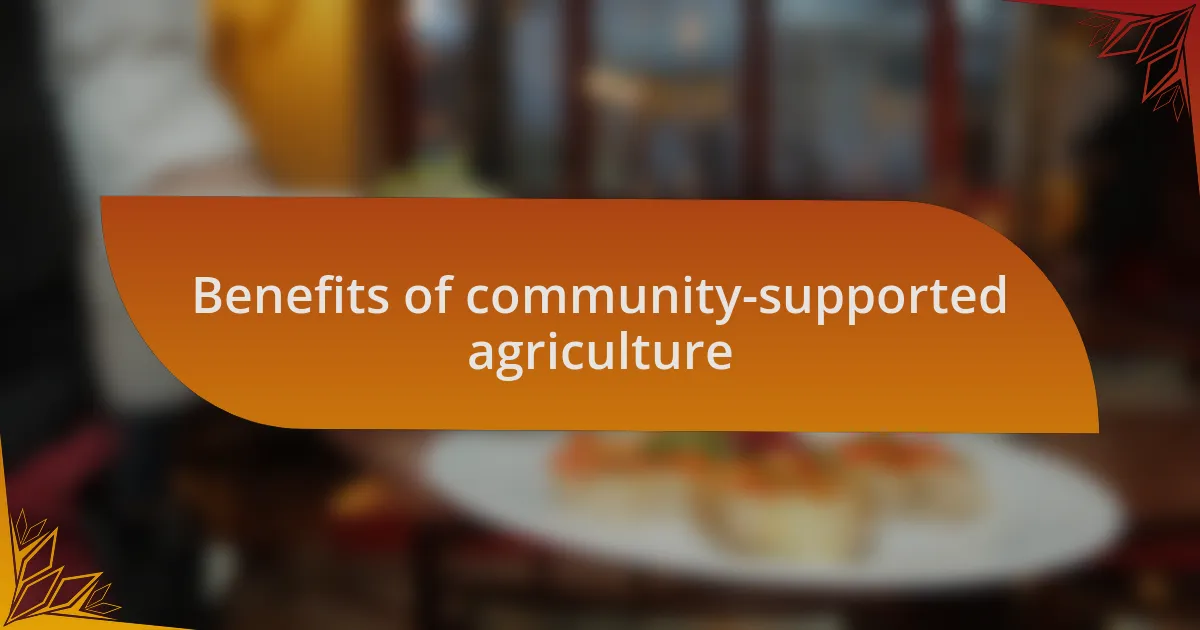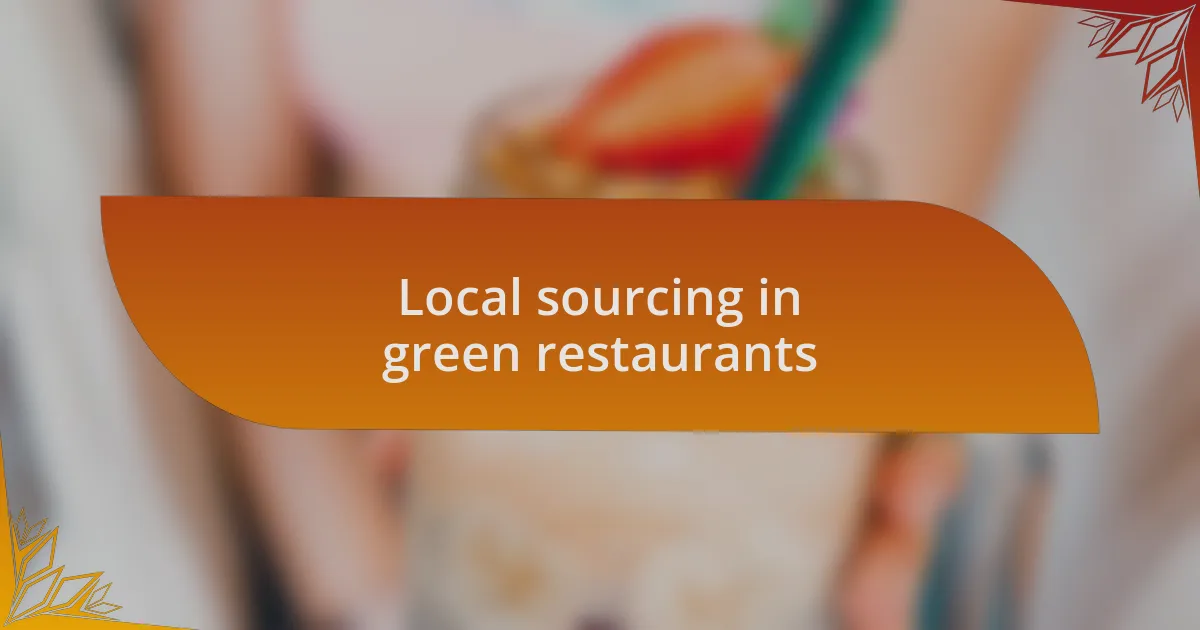Key takeaways:
- Community Supported Agriculture (CSA) connects consumers directly with local farms, allowing them to buy shares of the harvest, fostering a deeper appreciation for food and farming.
- Participating in CSA reduces carbon footprints by sourcing local produce, thus minimizing transportation emissions and enhancing environmental sustainability.
- Green restaurants leverage CSA for fresh, seasonal ingredients, creating innovative menus and strengthening community ties by showcasing local farmers.
- Engaging with CSA can lead to transformative experiences, such as discovering new flavors and building connections with fellow community members and local producers.

What is community supported agriculture
Community Supported Agriculture, or CSA, is a food system model that connects consumers directly with local farms. This concept allows individuals or families to buy “shares” of a farm’s harvest, creating a mutually beneficial relationship. I remember my first experience with CSA; it was like unwrapping a seasonal gift every week, filled with vibrant fruits and vegetables straight from the earth.
By participating in CSA programs, consumers become more than just buyers; they become stakeholders in the farming process. Have you ever wondered where your food comes from? When I signed up for a CSA, I not only supported local agriculture but also forged a deeper understanding of the cycles of nature. It’s a transformative way to appreciate food and the hard work behind it.
In addition to fresh produce, many CSAs offer a variety of products like flowers, eggs, and dairy, enriching the community’s connection to the land. This model fosters loyalty and gratitude as you watch the seasons change and the harvests evolve. How often do we take a moment to truly connect with what’s on our plates? Engaging in CSA brings this awareness to the forefront of our dining experience.

Benefits of community supported agriculture
Participating in community supported agriculture (CSA) can drastically reduce your carbon footprint. When I first started receiving my weekly harvest, I was amazed at how much closer I felt to my food. The environmental impact is significant; by opting for local produce, we cut down on transportation emissions, which makes a tangible difference for our planet. How refreshing is it to enjoy food that echoes the rhythms of the local landscape?
Another undeniable benefit of CSA is the incredible variety of fresh, seasonal produce it brings to our tables. I had my mind opened to unusual vegetables I’d never even seen at the grocery store. The joy of discovering new flavors and recipes has transformed my cooking routine into an adventurous exploration. Isn’t it delightful to create a meal with ingredients you’ve never worked with before?
Moreover, CSAs create a strong sense of community among participants. I remember attending a farm tour organized by my CSA, where I met fellow consumers and the farmers themselves. This experience strengthened my bond with the land and fostered lasting relationships. It’s truly rewarding to feel part of something bigger – don’t you think? Being part of a CSA means you’re not just eating locally; you’re actively participating in the local food ecosystem.

How green restaurants use CSA
Green restaurants utilize community supported agriculture (CSA) to source fresh ingredients while cultivating a direct connection with local farmers. I recall visiting a farm partnered with a local eatery; the chef was excitedly discussing how the week’s bounty influenced the menu. It’s fascinating to see how these restaurants not only reduce their environmental footprint but also celebrate the seasonal changes in their dishes.
Through CSA, these establishments gain access to unique, often rare ingredients that elevate their culinary offerings. I remember tasting an heirloom tomato I had never encountered before, and it was a revelation! Restaurants that embrace this model can craft dishes that reflect the vibrancy and diversity of their local agricultural landscape, creating a true farm-to-table experience.
Additionally, green restaurants foster community engagement by showcasing their CSA partners. I’ve seen them host events where diners can meet the farmers, creating a greater appreciation for the food they consume. It’s heartwarming to witness this synergy, where customers, chefs, and local producers unite, fostering a richer, more sustainable food culture. Isn’t it rewarding to know that dining out can contribute to something bigger than just a meal?

Local sourcing in green restaurants
When it comes to local sourcing, green restaurants often prioritize building relationships with their suppliers. I once visited a charming bistro that sourced all its produce from a nearby organic farm. The owners spoke passionately about their collaboration, emphasizing how their partnerships not only ensured quality ingredients but also strengthened the local economy. Isn’t it inspiring to think that every plate contributes to supporting your community?
Local sourcing creates a sense of trust between chefs and farmers, which can significantly influence a restaurant’s menu design. I remember dining at a place where the chef communicated with the farmers daily, adjusting the offerings based on what was freshly harvested. It’s remarkable how this immediate feedback loop leads to more innovative and relevant dishes. Experiencing such spontaneity in what I was eating made the meal feel more alive, as if I was part of something dynamic and ever-changing.
Furthermore, by sourcing locally, green restaurants can significantly reduce their carbon footprint, a goal crucial for sustainable dining. I recently learned that transporting food over long distances requires substantial fossil fuels, contributing to greenhouse gas emissions. Have you ever considered how much a meal’s impact could be minimized simply by choice? It’s empowering to realize that opting for local ingredients not only improves flavor but also helps protect the planet.

My experience with CSA
My experience with CSA has been nothing short of transformative. The first time I picked up my weekly box of fresh produce from a local farm, I felt a rush of excitement, like opening a gift filled with nature’s bounty. The vibrant colors and earthy scents put me in touch with the source of my food, making me appreciate each vegetable, fruit, and herb even more.
What surprised me was how much the flavors changed week by week, based on what’s in season. One afternoon, I found myself with an abundance of kale and decided to experiment with a new recipe. The satisfaction I felt while preparing a dish entirely from my CSA box was unparalleled, as it sparked a sense of creativity, connecting me to the changing rhythms of nature. Have you ever cooked with ingredients at their peak freshness? It’s a game changer.
In addition, being part of a CSA made me feel more closely tied to my community. I found joy in sharing recipes and experiences with other members, creating a culinary camaraderie that extended beyond the food itself. Knowing that I was supporting local farmers not only enhanced my meals but also filled me with a sense of purpose, as if each bite was a contribution to a larger, sustainable movement.

Recommendations for supporting CSA
One recommendation for supporting community-supported agriculture (CSA) is to share your experiences on social media. When I posted about my weekly haul, I was surprised by how many friends reached out, eager to learn more about it. Engaging with others not only spread the word about local farms but also fostered a sense of community, making each box feel even more special.
Another way to support CSA is by participating in farm events or volunteer days. I remember volunteering at a local farm’s harvest festival and was amazed at the connections I made. The hands-on experience deepened my appreciation for where my food comes from and allowed me to meet the farmers behind the produce. Have you ever worked side by side with those who grow your food? It truly transforms your perspective.
Consider also exploring subscription options that cater to the seasons, rather than just picking the standard boxes. I once opted for a summer vegetable share, which included unique varieties I had never tried before, like purple carrots and heirloom tomatoes. This variety not only expanded my palate but also kept me excited about meals. Isn’t it thrilling to discover new flavors right from your local farmers? Supporting a CSA becomes a delightful adventure when you embrace seasonal eating.